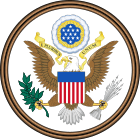Atomic Weapons Rewards Act of 1955 facts for kids
 |
|
| Long title | An Act to provide rewards for information concerning the illegal introduction into the United States or the illegal manufacture or acquisition in the United States, of special nuclear material and atomic weapons. |
|---|---|
| Acronyms (colloquial) | AWRA |
| Nicknames | Atomic Weapons and Special Nuclear Materials Rewards Act |
| Enacted by | the 84th United States Congress |
| Effective | July 15, 1955 |
| Citations | |
| Public law | 84-165 |
| Statutes at Large | 69 Stat. 365 |
| Codification | |
| Titles amended | 50 U.S.C.: War and National Defense |
| U.S.C. sections created | 50 U.S.C. ch. 4C § 47a et seq. |
| Legislative history | |
|
|
The Atomic Weapons Rewards Act of 1955 was a law in the United States. It allowed the government to pay rewards to people who gave information about illegal nuclear materials or weapons. This included information about these items being brought into the U.S., or made or bought illegally inside the country.
This law was created to help keep the United States safe. It aimed to stop dangerous nuclear materials from falling into the wrong hands. The rewards could be up to $500,000, with a minimum payment of $50,000. The U.S. President had to approve these payments.
The law also set up an "Awards Board." This board included important government officials. They were from the Treasury, Defense, Justice departments, plus the Central Intelligence Agency and the Atomic Energy Commission.
The bill for this law, called Senate Bill 609, was passed by the U.S. Congress. It was signed into law by President Dwight D. Eisenhower on July 15, 1955.
Contents
Understanding the Act's Sections
The Atomic Weapons Rewards Act had seven main parts. These sections explained how the law would work. They covered everything from how rewards would be paid to what certain words in the law meant.
Rewarding Information on Nuclear Materials
This part of the law explained that rewards would be given for details about illegal nuclear materials. This included "special nuclear material" (like fissile material used in bombs) or atomic weapons. It also set the limits for how much money could be paid out as a reward.
Setting Up the Awards Board
This section created the "Awards Board." This board was in charge of deciding if a reward should be given. They also decided the exact amount of the reward. The President had to give the final approval for any reward payment.
Rules for Non-Citizens
This part of the law was special for people who were not U.S. citizens. It said that if a non-citizen gave important information, they could be allowed to get a visa or even become a permanent resident in the United States. This was a way to encourage anyone with information to come forward.
How the Awards Board Works
This section explained how the Awards Board would hold its meetings. It also allowed the board to create or change its own rules for how it would operate. This helped make sure the process was fair and organized.
Approving the Rewards
This part of the law described the final steps for a reward to be paid. The Awards Board first had to approve the reward. After that, the President of the United States had to give their final approval.
Key Definitions in the Law
The last section of the Act provided clear definitions for important terms. This included what "Atomic Energy," "Atomic Weapon," "Special Nuclear Material," and "United States" meant within the law. This helped everyone understand the law clearly.
Later Changes to the Act
The Atomic Weapons Rewards Act was updated later on. In 1974, the U.S. Congress passed a new bill (Senate Bill 3669). This bill amended, or changed, the original 1955 Act. President Gerald Ford signed this updated law on August 17, 1974.

